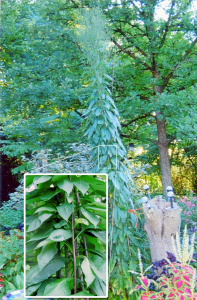Q. This plant came up in my back yard last summer. It grew to over 13 feet tall. I would like to know if you can identify it. – R.D., Lanesville, Ind.
A. That is an impressively tall volunteer! It is difficult to tell much detail in the photo about the flower structure, but considering the size, stem color and foliage, one possibility would be giant ironweed, Veronia gigantea. While this plant commonly reaches up to 10 feet tall, rich soil in garden conditions can result in taller plants.
Giant ironweed is a native species, and there are some cultivars in the trade. Did you observe purple flowers as the plants progressed? Have a look at https://www.fs.fed.us/wildflowers/plant-of-the-week/vernonia_gigantea.shtml to see if this looks like your plant. If not, and if the plant returns this year, you might consider submitting a sample to the Purdue Plant and Pest Diagnostic Lab.
Q. We are interested in getting soil samples from our garden to improve soil quality this year. Where is the best place to go to learn how to do this and submit samples? We would appreciate your help. – J.&M. W., West Lafayette, Ind.
A. You are wise to consider soil testing for your garden! Purdue Extension bulletin HO-071, Collecting Soil Samples for Testing, teaches you how to take soil samples for testing. It is available at
https://www.purdue.edu/hla/sites/yardandgarden/extpub/collecting-soil-samples-for-testing/.
Purdue also maintains a list of certified soil testing laboratories at
https://ag.purdue.edu/btny/ppdl/Documents/Compiled%20Lab%20Lists/PPDL-4-Soil%20Testing%20Labs-1.25.18.pdf.
Q. My flowers are being eaten by the Asian beetle. How do I get rid of these underground beetles? We also have bees. Is there a way to rid myself of these hungry beetles without killing our bees? – L.H., Wheatfield, Ind.
A. I applaud your concern for protecting bees! It is difficult to know which specific insect pest is in question, as there are a number of “Asian” beetle species. The control strategy will depend on a conclusive identification. Since you mention that they are underground, I wonder if you are talking about Japanese beetles. The adults chew on foliage and flowers, while their larvae (white grubs) feed on plant roots.
Purdue Entomology Extension provides an overview of identification and control in publication E-75, Japanese Beetles in the Urban Landscape, and includes a number of options that are less likely to harm bees. It is available at
https://www.purdue.edu/hla/sites/yardandgarden/wp-content/uploads/sites/2/2017/04/E-75.pdf.
Also, see Purdue Extension publication POL-1, Protecting Pollinators in Home Lawns and Landscapes at
https://www.purdue.edu/hla/sites/yardandgarden/wp-content/uploads/sites/2/2017/04/POL-1.pdf.
